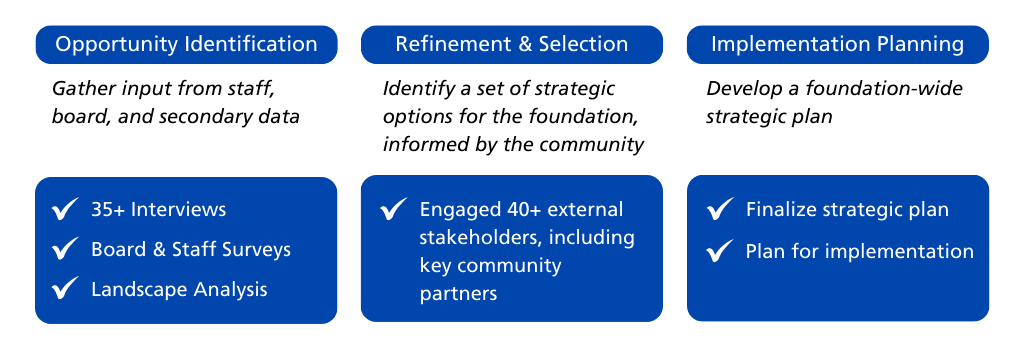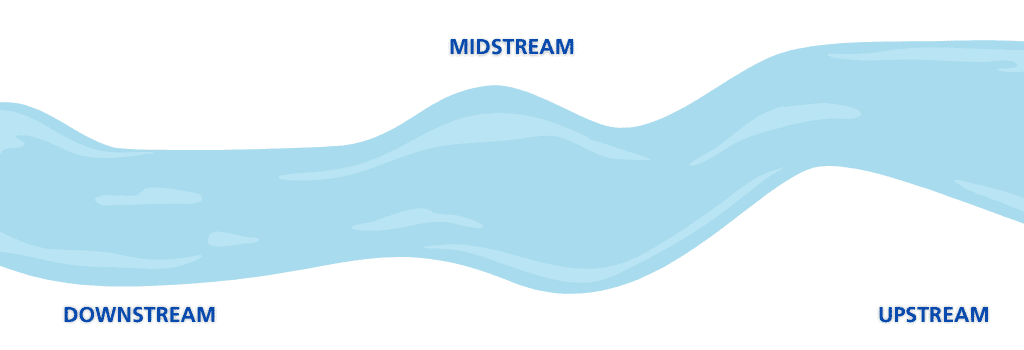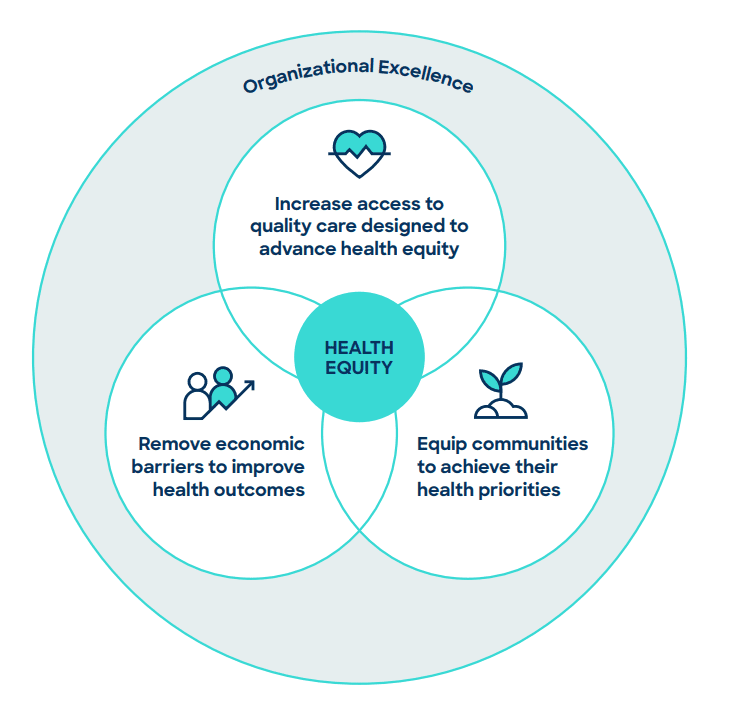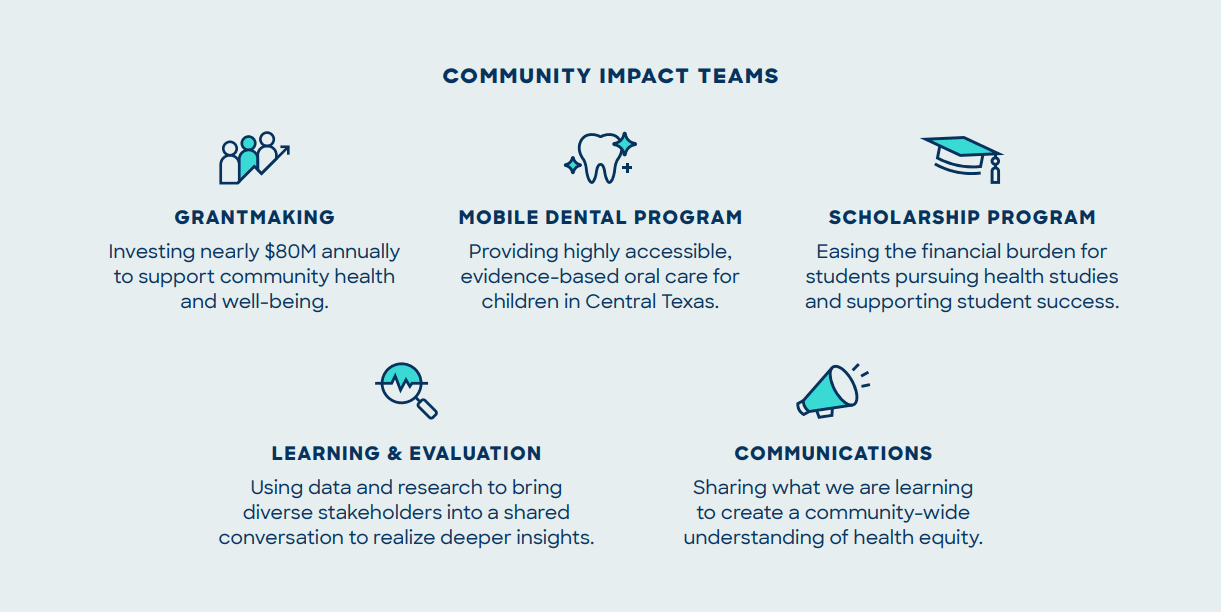St. David’s Foundation is one of the largest health foundations in the United States, funding more than $80 million annually in a five-county area surrounding Austin, Texas.
As a rapidly growing organization, St. David’s Foundation engaged FSG to develop a strategic plan to better operate as a unified organization and harness foundation-wide resources to achieve greater impact in Central Texas. The St. David’s Foundation 2024-2030 strategic plan, Pathways to Health Equity, reflects a strategy that unifies the organization towards a shared mission to advance health equity in Central Texas through investment and action.
Prior to working with FSG, the foundation had been on a journey to broaden its focus on healthcare to a more expansive mission of advancing health equity. However, many parts of the organization’s culture, structure, and operations did not yet align with this aspiration. For example, many of the foundation’s teams had become increasingly siloed. While the foundation’s grantmaking had grown rapidly over three decades, it was also delivering significant impact through its direct service programs, which include the largest mobile dental program in the country and the largest healthcare scholarship program in Texas. Despite this, the foundation had not previously leveraged the scholarship program as a strategy for addressing provider shortages. By supporting students from areas with the greatest gaps in care, the foundation could help create a pipeline of trained healthcare professionals who are more likely to return and practice in their hometowns after completing their training. To address these challenges, the organization needed a cohesive strategy to align all parts of the organization, ensuring every staff member felt included in its vision.
The Process

The strategic planning process included extensive engagement with the board, staff, and communities across the five counties where St. David’s Foundation operates. These inputs were also complemented by extensive research on the link between health outcomes and economic inequity in their service area of Central Texas and research on comparable foundations. Additionally, FSG engaged over 40 external stakeholders, including focus groups with parents, school nurses, city and county officials, health directors, medical staff, and interviews with community organizations, funders, and private sector stakeholders, to ensure that the plan was informed by the community. The final recommendations for St. David’s Foundation’s strategic plan were made by a working group of 18 staff members from across the organization.
Like many foundations, it was important to align both board and staff on a vision for the organization that centered on their core values—embracing risk-taking and innovation. From its initial landscape scan, FSG identified several strategic decision points to help provide greater alignment on the final foundation-wide strategy. FSG thoughtfully facilitated several key workshops using frameworks and activities that catalyzed thoughtful and meaningful conversations with the board and staff about the type of impact they wanted to have in Central Texas.
One critical decision point for the foundation was whether to increase their focus on upstream efforts. Historically, St. David’s Foundation had concentrated on direct services to address immediate healthcare needs in their community. However, the foundation was recognizing that ongoing health disparities could not be fully addressed through direct services alone.
In one workshop, the FSG team facilitated an activity where staff identified how much of their efforts were focused on immediate “today” needs (downstream) versus investing in “tomorrow” by addressing root causes of health disparities (upstream). Board members were also asked to participate in the same activity, showcasing their aspirations for the foundation in the future. Additionally, over 75% of respondents to both board and staff surveys agreed that the foundation’s future work should evolve to be evenly split between upstream and downstream. Seeing this depicted visually helped the foundation decide to increase their focus on investing in improved health for future generations, while continuing to support immediate healthcare needs. This shift acknowledges that both upstream and downstream approaches are necessary to effectively work toward health equity.

Another decision point for the foundation was how to allocate resources geographically based on their desire to advance health equity. Historically, funding had largely focused on Travis County (where Austin is located) due to population density and the location of many health-related nonprofit organizations. However, FSG shared data on two of the counties experiencing the largest health inequities who had historically received the least funding. These counties were also more rural and among the most racially and ethnically diverse areas of Central Texas.
To live into its commitment to advance health equity, the foundation realized that it also needed to actively advance racial equity. In one workshop, FSG shared data on how Central Texas’s history of slavery, segregation, racism, and redlining creates barriers to health for people of color through lower levels of public investment in education, infrastructure, housing, and transportation. The team also shared data on how Central Texas’ rapid population growth and rising housing costs are likely to widen health inequities.
Informed by the research, data, and community input, the board and staff decided to focus more of their investments and action in areas with the greatest health disparities. This also required a commitment to advancing racial equity and deepening community engagement—acknowledging that some of these communities may be populations and places where the foundation has less familiarity and fewer relationships.
The Impact

The final strategic plan contains a set of goals to help the foundation focus and prioritize its efforts over the next five years. Those goals are centered on supporting the people facing the greatest barriers and marginalization through 1) access to quality healthcare, 2) greater economic security, 3) community mobilization, and an internal goal focused on building organizational excellence.
While one pillar of their strategy remains focused on access to healthcare, the foundation has specifically named economic stability as one of their four pillars in recognition of the ways that social and economic conditions contribute to health inequities. Reflecting a decision to move into a deeper relationship with community members, the foundation is engaging in four open grant calls this year where any eligible nonprofit can apply with a straightforward process to submit a letter of intent. While past grant cycles have been invite-only, the foundation is committing to an open process which will allow it to engage with new communities and organizations, particularly with grassroots organizations led by or serving communities of color. The foundation is also committed to leadership development and civic engagement activities in historically underinvested areas with highest health inequities to help those communities develop the leaders and organizations they need to absorb funding.

With their new foundation-wide strategic plan, every team can see themselves represented in the organization’s vision. Previous planning efforts had also been siloed among external facing teams, namely grantmaking and community programs, and had not reflected priorities for internal operations. Now, the organization is structured into five community impact teams: Grantmaking, Mobile Dental Program, Scholarship Program, Learning & Evaluation, and Communications that are all organized around a unifying theme of advancing health equity. This allows the organization to operate as a unified foundation with alignment on shared goals, processes that support greater connectivity, and culture change.
In 2024, the organization is focusing on developing the infrastructure to support their new strategic plan. This effort will include continued community listening and opportunities to shape future funding and programmatic priorities.
By increasing its focus on upstream efforts, St. David’s Foundation is also investing in long-term impact to improve health for future generations—while continuing to address immediate community needs. With its new strategic plan and rapid growth over the past three decades, the foundation is gaining the capacity to pursue initiatives that others may lack the resources or ability to undertake. These strategic decisions support the foundation’s desire to embody an organizational culture of innovation, risk-taking, and effective failure.
We needed a strategic planning partner who would actively listen and guide us with deep knowledge of philanthropy and health equity. FSG’s skills as an intentional facilitator provided the ability for our team to have meaningful and vulnerable conversations about our biggest organizational challenges.” – Dr. Edward Burger, President and CEO, St. David’s Foundation
About St. David’s Foundation
St. David’s Foundation is one of the largest health foundations in the United States, funding over $80 million annually in a five-county area surrounding Austin, Texas. Through a unique partnership with St. David’s HealthCare, we strategically reinvest proceeds from the hospital system back into the community, with the goal of advancing health equity and improving the health and well-being of our most underserved Central Texas neighbors.
Beyond our grantmaking work, we operate the largest mobile dental program in the country providing charity care and offer the largest healthcare scholarship program in Texas, the St. David’s Neal Kocurek Program.
Through investments and action, we are committed to centering health equity in all that we do so that all Central Texans have a fair chance to achieve optimal health with no avoidable, unjust, or systematically caused differences in health status due to ethnicity, race, age, ability, or geography.




